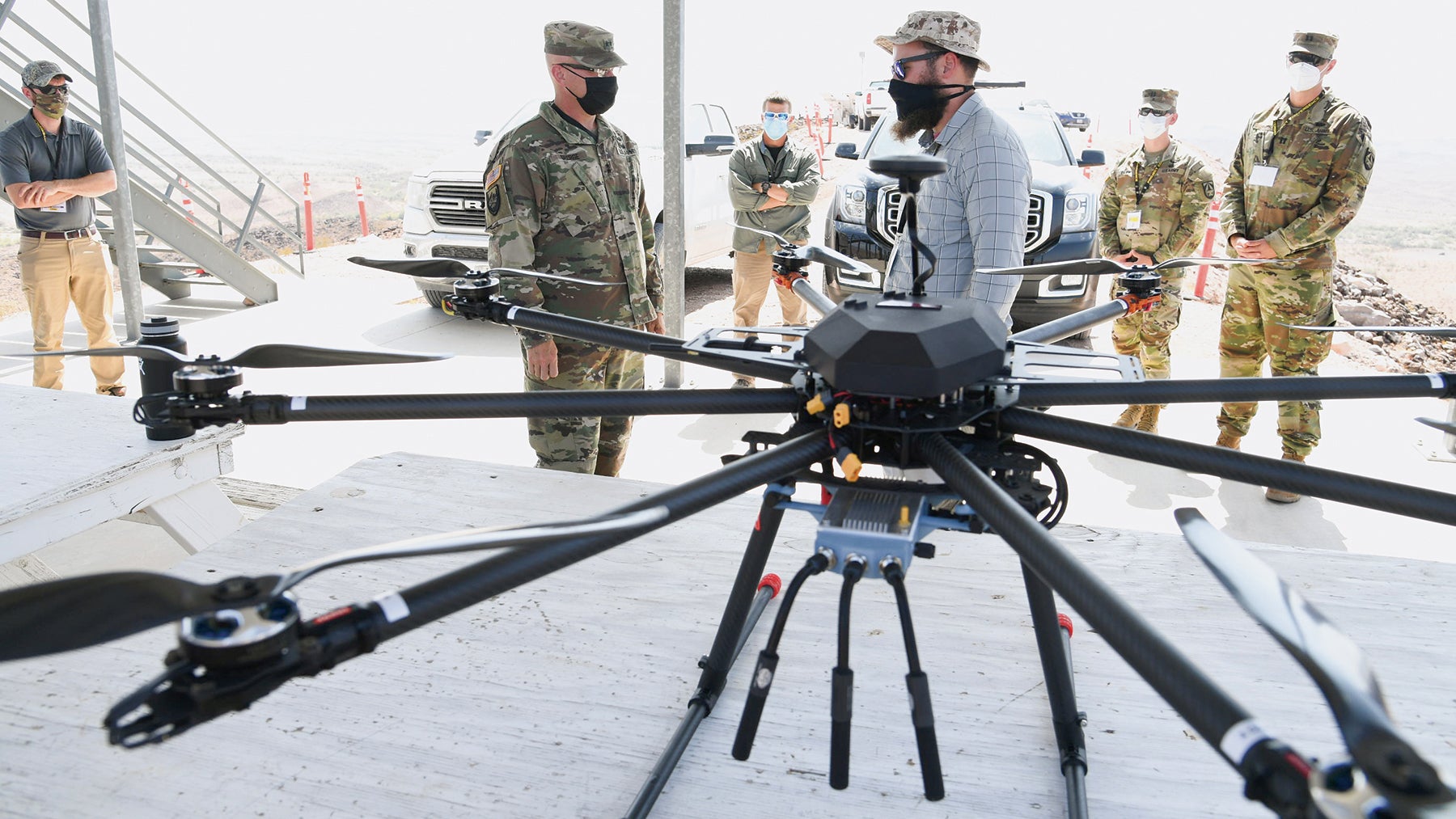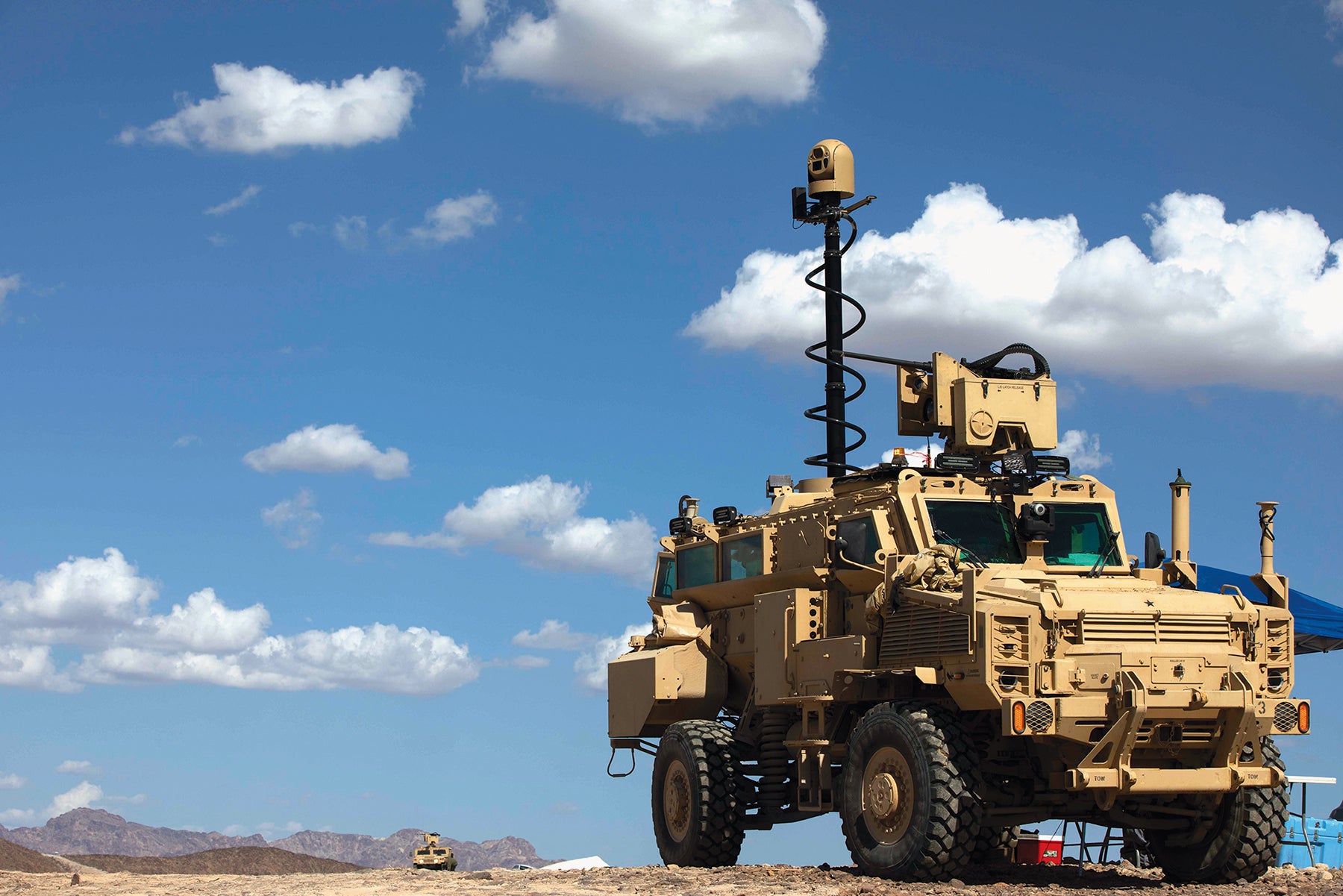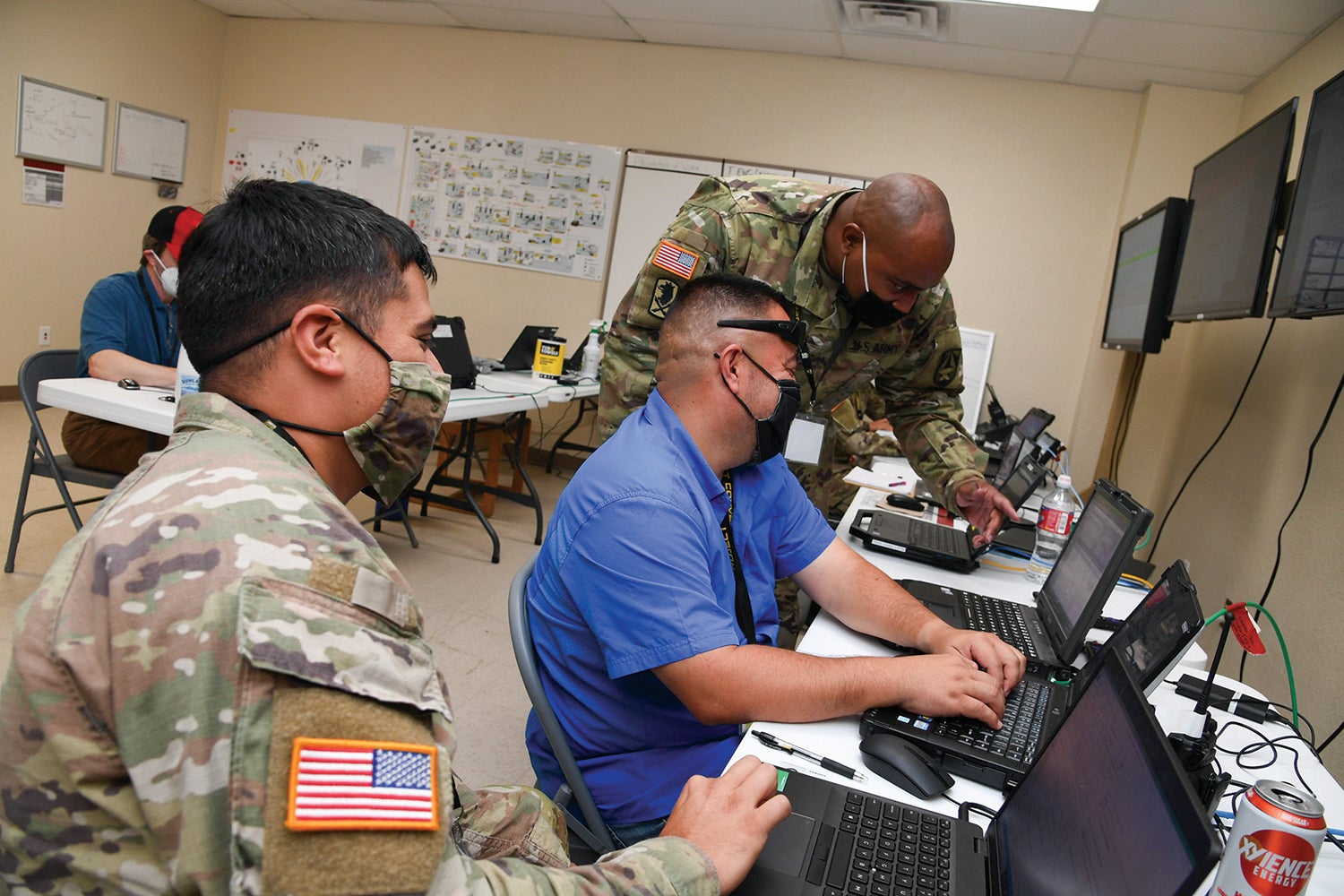MAJ. GEN. JOHN GEORGE
Many of the most important capabilities on the future battlefield will depend on getting data and information to and from soldiers at the tactical edge. Sensors, artificial intelligence and machine learning are examples of key technologies that gather data, interpret it and send it to commanders and other critical combatants so they can make better decisions faster than their adversaries.
Developing these technologies into the data-enabled capabilities the Army needs requires the scientists and engineers of the U.S. Army Combat Capabilities Development Command, also known as DEVCOM, to take the technologies they are working on today out of the lab and into the dirt where soldiers can use them and provide feedback.
The Army’s learning campaign to make that a reality is Project Convergence, a continuous, structured series of demonstrations and experiments announced in 2020 by Gen. Mike Murray, commanding general of the U.S. Army Futures Command. Collecting and analyzing data from various technologies, then sending it to soldiers was one of the key objectives at the Army’s capstone Project Convergence 20 exercise, which was held at Yuma Proving Ground, Arizona, in September. The “20” in the name of the exercise stands for the year 2020.
Several of the Army’s most senior leaders noted that in 20 years, the exercise may be referred to as the “Yuma Maneuvers,” a reference to the Louisiana Maneuvers of 1941. A key indicator of its success was showing the potential to cut the time it takes to identify and fire on some targets from tens of minutes to tens of seconds.

New technology like this unmanned aerial vehicle made an appearance during Project Convergence 20 at Yuma Proving Ground, Arizona, where the U.S. Army Combat Capabilities Development Command played a critical role.
(Credit: U.S. Army U.S. Army/Tom Falkner)
Taking the Lead
DEVCOM was a leading member of the team of teams that executed this event. More than 160 DEVCOM scientists, engineers, technicians and analysts took part. Over 20 of the 34 potential technologies demonstrated at Project Convergence were DEVCOM systems. DEVCOM’s Army Research Laboratory and seven centers are a global team of teams that work together to deliver the best technology for soldiers.
As DEVCOM develops new technologies, we seek opportunities to leverage field experiments, live-fire exercises and other touch points to gather soldier feedback to inform what we call soldier-centered design. Project Convergence is one of the opportunities where we took our developmental technologies into a realistic combat environment to troubleshoot with soldiers in real time.
Project Convergence was designed to aggressively advance and integrate the Army’s contributions to the joint force. It will ensure that the Army, as part of a joint and combined fight, can rapidly and continuously converge effects across all domains—air, land, sea, space and cyberspace—to defeat adversaries. One of the key challenges is how to connect sensors, weapons, communications capabilities and data-sharing across the services into a single network.
“Constantly measuring our current capabilities against an unknown future threat is exactly what [Futures Command] was created to do, and Project Convergence is how we’re going to do it,” Murray said. “It’s artificial intelligence. It’s machine learning. … It’s the network that will support all that. It’s autonomy, it’s robotics, and it’s really the underlying data architectures and how we manage data, because when you boil it right down, it all comes down to how you manage that data.”
Penetrate, Disintegrate, Exploit
DEVCOM’s Data and Analysis Center partnered with Futures Command’s Research and Analysis Center and the U.S. Army Test and Evaluation Command to collect data across the three key phases of Project Convergence: penetrate, disintegrate and exploit. The team developed three overarching objectives:
Develop a baseline of how the Army works today.
Find areas where artificial intelligence can support the Army.
Leverage doctrine, organization, training, materiel, leadership, education, personnel and facilities for possible nonmateriel solutions.
The Data and Analysis Center and other DEVCOM organizations worked with multiple partners to make sure DEVCOM’s work at Project Convergence supported the exercise’s scheme of maneuver and the Army modernization priorities.
Over 750 soldiers, scientists, engineers, technicians and analysts participated in Project Convergence from three locations spread over 3,000 miles. The Data and Analysis Center team, which was located at Joint Base Lewis-McChord, Washington, and Yuma Proving Ground, collected data about decision-making and outcomes, including message receipt times, process times, human intervention actions and times, and air mission send times. A Next-Generation Combat Vehicle MRAP surrogate participates in a live-fire exercise during Project Convergence 20 at Yuma Proving Ground, Arizona.
A Next-Generation Combat Vehicle MRAP surrogate participates in a live-fire exercise during Project Convergence 20 at Yuma Proving Ground, Arizona.
 A Next-Generation Combat Vehicle MRAP surrogate participates in a live-fire exercise during Project Convergence 20 at Yuma Proving Ground, Arizona.
A Next-Generation Combat Vehicle MRAP surrogate participates in a live-fire exercise during Project Convergence 20 at Yuma Proving Ground, Arizona.(Credit: U.S. Army/Spc. Carlos Cuebas Fantauzzi)
The data was sent to a DEVCOM Command, Control, Communications, Computers, Cyber, Intelligence, Surveillance and Reconnaissance (C5ISR) Center/Data and Analysis Center team at Aberdeen Proving Ground, Maryland, where it was sorted by date, site and type of information, then uploaded to a web-based repository where the Project Convergence 20 analytic community could access it.
Observing the Operator
The Data and Analysis Center team also observed the nonmateriel space—what the operator was doing during the event, whether something could be done more efficiently, and whether there were any observations that could add depth to the analysis. The team compiled a final report with all the information—types of data collected, capabilities demonstrated, successes and lessons learned. The information is being used as part of Project Convergence 2021 planning now underway.
DEVCOM’s C5ISR Center and Army Research Laboratory collected, curated and labeled vast amounts of image and targeting data in environments that are important to the Army to train and evaluate machine learning algorithms using state-of-the-art day and night infrared sensors. Machine learning algorithms require large amounts of data to create advanced training programs necessary for precise, aided target recognition. For example, a typical target may require more than 30,000 labeled images to identify it, while more complex tasks including decision support require significantly more data.
Working With Partners
DEVCOM works closely with its extensive network of industry and academic partners. Government, industry and academic partners used the Project Convergence 20 data to train and evaluate algorithms used during the demonstration. Even data collected from the desert at Yuma Proving Ground will prove useful. Future battles will be fought in dynamic environments across multiple domains, which will require more diverse data to create more realistic combat scenarios for soldier training. Advanced training will enable soldiers to move from one distinct area of operations to another.
Collecting quality data is important for both training and testing artificial intelligence models. The C5ISR and Army Research Lab team produced and labeled 3.8 million images from multiple environments, including Fort Hunter Liggett, California, Fort A.P. Hill, Virginia, and Fort Bliss, Texas, for artificial intelligence-enabled capability development. U.S. Army Combat Capabilities Development Command scientists, engineers, technicians and analysts took technologies they are working on out of the lab and ‘into the dirt’ during Project Convergence 20.
U.S. Army Combat Capabilities Development Command scientists, engineers, technicians and analysts took technologies they are working on out of the lab and ‘into the dirt’ during Project Convergence 20.
 U.S. Army Combat Capabilities Development Command scientists, engineers, technicians and analysts took technologies they are working on out of the lab and ‘into the dirt’ during Project Convergence 20.
U.S. Army Combat Capabilities Development Command scientists, engineers, technicians and analysts took technologies they are working on out of the lab and ‘into the dirt’ during Project Convergence 20.(Credit: U.S. Army U.S. Army/Tom Falkner)
The team collected an additional 76 gigabytes of data at Yuma Proving Ground. The Army Research Lab team created a secure web-based environment called the Army Artificial Intelligence Innovation Institute to collaboratively curate, label and assess data; train artificial intelligence algorithms in a predictable, repeatable manner; and gather developmental feedback.
Creating a FIRESTORM
One of the key technologies demonstrated at Project Convergence 20 was FIRES Synchronization to Optimize Responses in Multi-Domain Operations, or FIRESTORM. The DEVCOM Armaments Center demonstrated FIRESTORM, which significantly increases soldier lethality and survivability by speeding up the decision-making, planning, coordination and communications involved from when a target is identified to when a fire mission is executed. FIRESTORM provides soldiers with the data flow of information from the top down and bottom up, bringing them together to support the rapid execution of fires.
The government-owned and -developed software capability leverages artificial intelligence algorithms with large amounts of data from sensors and humans on subjects such as terrain, weather, intent, capabilities and projected enemy movements. The artificial intelligence algorithms also incorporate past experience, behavior models and data accuracy with current operational data and real-time learning to project operations in future time and space. Together, the artificial intelligence tools provide the commander with recommendations to help achieve the rapid execution of fires.
Busy Schedule
The Army has more than 250 soldier-centered lab and field experiments planned over the next 15 months. The U.S. Army Joint Modernization Command is tracking over 90 technologies slated to be part of Project Convergence 21, including 27 DEVCOM technologies that will take part in one or more exercise missions, and eight other technologies that will be evaluated as part of Project Convergence 21. DEVCOM will be demonstrating technologies as often as every two weeks over the coming year.
Key to learning how to handle all that data during all these events is the DEVCOM C5ISR Center Systems Integration Laboratory at Aberdeen Proving Ground. It will provide a controlled, advanced lab environment for our extensive network of industry partners and DoD science and technology experts to evaluate and integrate new capabilities into the current and next-generation tactical network before they are used in field-based experiments.
The Systems Integration Lab leverages more than 70 cooperative research and development agreements with various industry partners, enabling industry and government teams to work together to test and integrate technology.
Critical to this campaign of learning is working side by side with soldiers in the field, seeing firsthand what works and what needs to be adjusted. These experiments, including Project Convergence 20, provide not only important information but also valuable lessons learned that will ensure DEVCOM’s success in delivering the cutting-edge capabilities soldiers will need to dominate on a future battlefield.
Maj. Gen. John George became commanding general of the U.S. Army Combat Capabilities Development Command, Aberdeen Proving Ground, Maryland, on Nov. 1, 2019. Previously, he served as deputy director and chief of staff of the U.S. Army Futures Command Futures and Concepts Center. He graduated from the U.S. Military Academy at West Point, New York, and was commissioned into the Army in 1988. He has a master’s degree in social psychology from Penn State and a master’s in national resource strategy from the Industrial College of the Armed Forces.
No comments:
Post a Comment